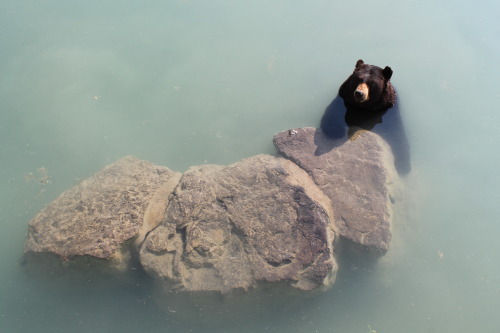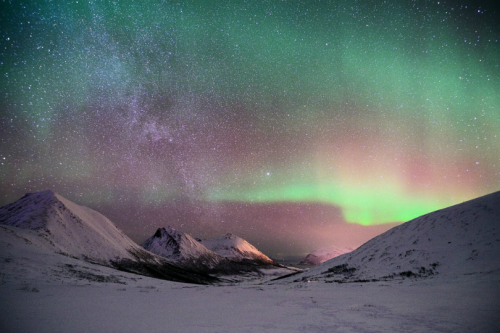64 posts
Latest Posts by novato-curioso-blog - Page 2
Quién tuviera una cabaña como esta.

Reflections In Olympic National Park by Alex Bailey
Instagram | Website

Hermoso!!!

Antoine Calbet - Ondines
Por favor disfruten esta magnífica fotografía. El momento, la precisión, todo es fantástico.

. A blue shark surfaces near Santa Maria in the Azores. Photograph: Nuno Sa/NPL/Alamy. #Shark #Azores #SantaMaria
Nuestro maravilloso planeta!!!

by Brock Sanders

 What’s that in front of the Moon? It’s the International Space Station. Using precise timing, the Earth-orbiting space platform was photographed in front of a partially lit Moon last year. The featured image was taken from Madrid, Spain with an exposure time of only 1/1000 of a second. In contrast, the duration of the transit of the ISS across the entire Moon was about half a second. The sun-glinting station can be seen just to the dark side of the day / night line known as the terminator. Numerous circular craters are visible on the distant Moon, as well as comparatively rough, light colored terrain known as highlands, and relatively smooth, dark colored areas known as maria. On-line tools can tell you when the International Space Station will be visible from your area.
Object Names: Moon, ISS
Image Type: Astronomical
Credit: Dani Caxete
Time And Space>b
Viva Polonia

RIO2016: Maria Andrejczyk finishes 4th in Athletics - Women’s Javelin Throw. #TeamPoland #POL
Que hermoso animal. Por favor colaboremos con su preservación!!

Tundra Gray Wolf by Cheryl Nestico
Ohhhh el.Partenon, otra maravilla que espero poder conocer!!

Frederic Edwin Church, Parthenon, Athens, from the Northwest (Illuminated Night View), 1869 (source).
Por favor disfruten esta hermosa foto. Por un momento cierren sus ojos e imagínense ahí. Que maravilla no?

Rockesholm
Arte en ruedas! Qué tal eh?


Wasatch Mountains
Hermoso, no?

These three bright nebulae are often featured in telescopic tours of the constellation Sagittarius and the crowded starfields of the central Milky Way. In fact, 18th century cosmic tourist Charles Messier cataloged two of them; M8, the large nebula left of center, and colorful M20 on the right. The third, NGC 6559, is above M8, separated from the larger nebula by a dark dust lane. All three are stellar nurseries about five thousand light-years or so distant. The expansive M8, over a hundred light-years across, is also known as the Lagoon Nebula. M20’s popular moniker is the Trifid. Glowing hydrogen gas creates the dominant red color of the emission nebulae, with contrasting blue hues, most striking in the Trifid, due to dust reflected starlight. This broad skyscape also includes one of Messier’s open star clusters, M21, just above and right of the Trifid.
Object Names: M8, M20, M21, NGV 6559
Image Type: Astronomical
Credit: Martin Pugh
Time And Space
Por favor disfruten las imágenes de la aurora boreal, son colosales!!!!




Nightsky / Tromvik, Norway by John A Hemmingsen

TODAY IN HISTORY: The rings of Saturn, August 17, 1981, in an enhanced view from the Voyager 2 space probe, assembled from clear, orange and ultraviolet frames taken at a distance of 8.9 million km (5.5 million miles). (NASA)
He de volar en globo!!!

by Manu Hansen ( tumblr )
Seres como ella son los que ratifican la valía del ser humano. Y créanme, son pocos.

“Every child saved with my help and the help of all the wonderful secret messengers, who today are no longer living, is the justification of my existence on this earth, and not a title to glory.”
- Irena Sendler (15 February 1910 – 12 May 2008), the woman who smuggled more than 2,500 Jewish children out of the Warsaw Ghetto, saving their lives.

One of the brightest galaxies in planet Earth’s sky is similar in size to our Milky Way Galaxy: big, beautiful M81. The grand spiral galaxy can be found toward the northern constellation of the Great Bear (Ursa Major). This superbly detailed image reveals M81’s bright yellow nucleus, blue spiral arms, tell tale pinkish star forming regions, and sweeping cosmic dust lanes with a scale comparable to the Milky Way. Hinting at a disorderly past, a remarkable dust lane actually runs straight through the disk, to the left of the galactic center, contrary to M81’s other prominent spiral features. The errant dust lane may be the lingering result of a close encounter between between M81 and its smaller companion galaxy, M82. Scrutiny of variable stars in M81 has yielded one of the best determined distances for an external galaxy – 11.8 million light-years. M81’s dwarf companion galaxy Holmberg IX can be seen just above the large spiral.
Object Names: M81
Image Type: Astronomical
Credit: Ken Crawford (Rancho Del Sol Observatory)
Time And Space
Maravilloso!!!

Sculpted by stellar winds and radiation, the star factory known as Messier 17 lies some 5,500 light-years away in the nebula-rich constellation Sagittarius. At that distance, this 1/3 degree wide field of view spans over 30 light-years. The sharp composite, color image, highlights faint details of the region’s gas and dust clouds against a backdrop of central Milky Way stars. Stellar winds and energetic light from hot, massive stars formed from M17 stock of cosmic gas and dust have slowly carved away at the remaining interstellar material producing the cavernous appearance and undulating shapes. M17 is also known as the Omega Nebula or the Swan Nebula.
Object Names: Omega Nebula/ Swan Nebula/ M17
Image Type: Astronomical
Credit: ESO/ MPIA/ OAC
Asembly: R. Colombari
Time And Space
Solo por el placer de disfrutar un hermoso paisaje.

Tumbler Ridge

Kyle Of Lochalsh, Highland, United Kingdom

Karlskoga
Un maravilloso encuentro!!!

Will either of these galaxies survive? In what might be dubbed as a semi-final round in a galactic elimination tournament, the two spirals of NGC 7318 are colliding. The featured picture was created from images taken by the Hubble Space Telescope. When galaxies crash into each other, many things may happen including gravitational distortion, gas condensing to produce new episodes of star formation, and ultimately the two galaxies combining into one. Since these two galaxies are part of Stephan’s Quintet, a final round of battling galaxies will likely occur over the next few billion years with the eventual result of many scattered stars and one large galaxy. Quite possibly, the remaining galaxy will not be easily identified with any of its initial galactic components. Stephan’s Quintet was the first identified galaxy group, lies about 300 million light years away, and is visible through a moderately-sized telescope toward the constellation of the Winged Horse (Pegasus).
Object Names: NGC 7318, Stephan’s Quintet
Image Type: Astronomical
Credit: Hubble Legacy Archive, NASA, ESA (Via Nasa’s APOD)
Pocesing And Copyright: José Jimenez Priego
Time And Space

This dance is to the death. Along the way, as these two large galaxies duel, a cosmic bridge of stars, gas, and dust currently stretches over 75,000 light-years and joins them. The bridge itself is strong evidence that these two immense star systems have passed close to each other and experienced violent tides induced by mutual gravity. As further evidence, the face-on spiral galaxy on the right, also known as NGC 3808A, exhibits many young blue star clusters produced in a burst of star formation. The twisted edge-on spiral on the left (NGC 3808B) seems to be wrapped in the material bridging the galaxies and surrounded by a curious polar ring. Together, the system is known as Arp 87 and morphologically classified, technically, as peculiar. While such interactions are drawn out over billions of years, repeated close passages should ultimately result in the death of one galaxy in the sense that only one galaxy will eventually result. Although this scenario does look peculiar, galactic mergers are thought to be common, with Arp 87 representing a stage in this inevitable process. The Arp 87 pair are about 300 million light-years distant toward the constellation Leo. The prominent edge-on spiral at the far left appears to be a more distant background galaxy and not involved in the on-going merger.
Object Names: Arp 87
Image Type: Astronomical
Credit: NASA, ESA, HST
Time And Space
Guau!!!!

What’s that rising over the edge of the Moon? Earth. About 47 years ago, in December of 1968, the Apollo 8 crew flew from the Earth to the Moon and back again. Frank Borman, James Lovell, and William Anders were launched atop a Saturn V rocket on December 21, circled the Moon ten times in their command module, and returned to Earth on December 27. The Apollo 8 mission’s impressive list of firsts includes: the first humans to journey to the Earth’s Moon, the first to fly using the Saturn V rocket, and the first to photograph the Earth from deep space. As the Apollo 8 command module rounded the farside of the Moon, the crew could look toward the lunar horizon and see the Earth appear to rise, due to their spacecraft’s orbital motion. Their famous picture of a distant blue Earth above the Moon’s limb was a marvelous gift to the world.
Object Names: Earth, Moon
Image Type: Astronomical
Credit: Nasa, Apolo 8 Crew
Time And Space
Nuestro Universo, simple y sencillamente FASCINANTE. Les recomiendo ampliamente este blog Thetimeandsoaceblog, publica unas fotos admirables.

Very faint but also very large on planet Earth’s sky, a giant Squid Nebula cataloged as Ou4, and Sh2-129 also known as the Flying Bat Nebula, are both caught in this scene toward the royal constellation Cepheus. Composed with a total of 20 hours of broadband and narrowband data, the telescopic field of view is almost 4 degrees or 8 Full Moons across. Discovered in 2011 by French astro-imager Nicolas Outters, the Squid Nebula’s alluring bipolar shape is distinguished here by the telltale blue-green emission from doubly ionized oxygen atoms. Though apparently completely surrounded by the reddish hydrogen emission region Sh2-129, the true distance and nature of the Squid Nebula have been difficult to determine. Still, a recent investigation suggests Ou4 really does lie within Sh2-129 some 2,300 light-years away. Consistent with that scenario, Ou4 would represent a spectacular outflow driven by a triple system of hot, massive stars, cataloged as HR8119, seen near the center of the nebula. If so, the truly giant Squid Nebula would physically be nearly 50 light-years across.
Object Names: Squid Nebula/Ou4, Flying Bat Nebula/Sh2-129
Image Type: Astronomical
Credit: Steve Canistra (Starry Wonders)
Time And Space
Guau!! Muero por conocerlo!!! Esta es una verdadera maravilla de la arquitectura para el entretenimiento. Sádico y terrible , pero entretenimiento. Lo importante del lugar es su funcionalidad y perfección de construcción.

The Roman Colosseum.
La arquitectura fundida con el arte se convierte en una obra de enseñanza histórica. En ellas podemos leer los sucesos de los grandes éxitos militares de la época.





Reliefs on the column of Marcus Aurelius | 2nd Century AD
Otra maravilla romana, ésta ubicada en Efeso

Library of Celsus in Ephesus.



Gold Egyptian mummy casket at Metropolitan Museum of Art, New York City
By Brandon Falls
Incredible detail, click pictures for hi-res